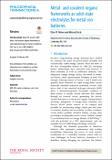Metal- and covalent-organic frameworks as solid-state electrolytes for metal-ion batteries
Author(s)
Miner, Elise Marie; Dinca, Mircea
DownloadPublished version (1.032Mb)
Terms of use
Metadata
Show full item recordAbstract
Society's long-standing energy demands have fuelled for centuries the quest for power-dense, portable and economically viable energy carriers. Since the birth of the first rechargeable battery in 1860, emerging battery technologies have provided both answers to these demands as well as additional obstacles. One ubiquitous energy storage device, the metal or metal-ion battery, offers quintessential examples of both. The strongly reducing nature of Group 1 and 2 metal ions qualifies these elements as viable energy-dense anode materials: standard reduction potentials several volts below that of the standard hydrogen electrode (SHE) allow a thermodynamically favourable oxidation of these metals to readily release electrons that shuttle through an external circuit, generating the electric current that serves as the power supply during battery discharge. Integration of energy-dense materials into devices allows power sources to be compact and portable, by maximizing energy output per unit mass of material. Further, the reversibility of these oxidation events makes possible extensive battery cycling, thus providing a rechargeable power source. Indeed, current Li-ion batteries boast an energy density of 265 Wh kg−1, with the potential of a 20% improvement, and are operable for over 1000 charge-discharge cycles.
Date issued
2019-05Department
Massachusetts Institute of Technology. Department of ChemistryJournal
Philosophical Transactions of the Royal Society A
Publisher
The Royal Society
Citation
Miner, Elise Marie, and Mircea Dinca. "Metal- and covalent-organic frameworks as solid-state electrolytes for metal-ion batteries." Philosophical Transactions of the Royal Society A 377, 2149 (May 2019): no. 20180225 doi 10.1098/RSTA.2018.0225 ©2019 Author(s)
Version: Final published version
ISSN
2053-9223